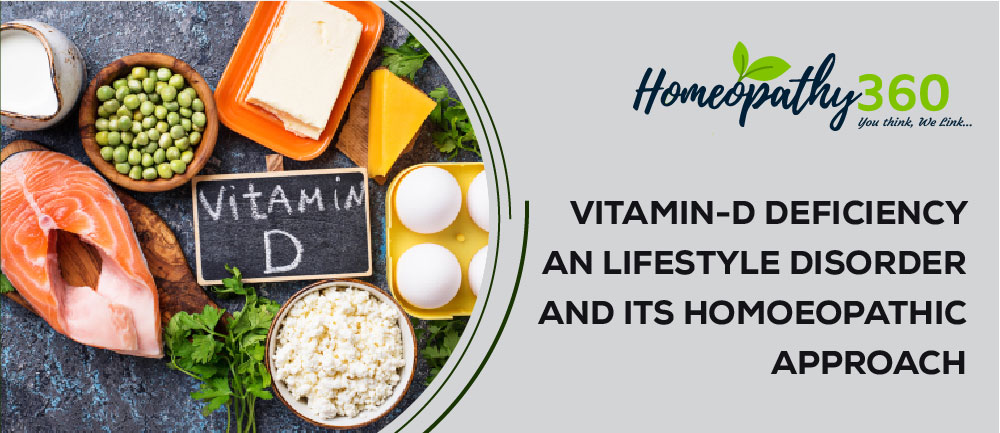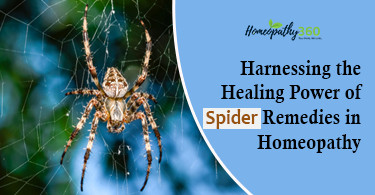
Abstract: Vitamin D deficiency occurs when people do not have an appropriate dietary intake or exposure to UVB rays. Symptoms may include muscle weakness, bone fragility, fracture of bone and fatigue. Complications may leads to rickets in children and osteomalacia, osteoporosis in elderly.
Keyword: vitamin D deficiency, homoeopathy.
Abbreviations: ultraviolet B(UVB), highly active antiretroviral therapy(HAART), parathyroid hormone(PTH), milligram(mg), international unit(IU), Acquired immunodeficiency syndrome (AIDS).
Introduction
The natural form of vitamin D, cholecalciferol or vitamin D3, is formed in the skin by the action of UV light on 7-dehydrocholesterol, a metabolite of cholesterol. Few foods contain vitamin D naturally and skin exposure to sunlight is the main source.(1) Vitamin D is a fat-soluble vitamin. There are two chemical forms of vitamin D; ergocalciferol (vitamin D2) and cholecalciferol (vitamin D3). Ergocalciferol is present in food. Cholecalciferol is synthesized in the skin on exposure to sunlight from 7-dehydrocholesterol.
Physiology
Vitamin D is converted in the liver to 25-hydroxy vitamin D (25(OH)D), which is further hydroxylated in the kidneys to 1,25-dihydroxy-vitamin D (1,25 (OH)2D), the active form of the vitamin. 1,25 (OH)2D activates specific intracellular receptors which influence calcium metabolism, bone mineralisation and tissue differentiation.(1)
Functions
| Intestine | Promotes intestinal absorption of calcium and phosphorus. |
| Bone | Stimulates normal mineralization, enhances bone reabsorption, affects collagen maturation. |
| Kidney | Increases tubular reabsorption of phosphate, variable effect on reabsorption of calcium. |
| Other | Permits normal growth. |
Table showing functions of vitamin D(2)
Causes
Reduced skin synthesis:
Sunscreen use- absorption of UVB radiation by sunscreen
Skin pigment- absorption of UVB radiation by melanin
Aging- reduction of 7-dehydrocholesterol in the skin
Skin grafts for burns- reduction of 7-dehydrocholesterol in the skin
Decreased bioavailability
Malabsorption- reduction in fat absorption
Obesity- sequestration of vitamin D in body fat
Increased catabolism
Anticonvulsants, glucocorticoids, HAART (AIDS treatment) and antirejection medications
Breast feeding
Poor vitamin D content in human milk
Decreased synthesis of 25-hydroxyvitamin D
Liver failure
Increased urinary loss of 25-hydroxyvitamin D
Nephrotic syndrome
Decreased synthesis of 1,25-dihydroxyvitamin D
Chronic kidney disease(3)
Clinical features
Vitamin D deficiency leads to rickets, which is usually seen in young children between the age of six months and two years.
At birth, neonatal rickets may present as ‘craniotabes’.
In the first few years of life there may be widened epiphyses at the wrists and beading at the costochondral junctions, producing the ‘rickety rosary’, or a groove in the rib cage (Harrison’s sulcus).
In older children, lower limb deformities are seen.
A ‘myopathy’ may also occur.
‘Hypocalcaemic tetany’ may occur in severe cases.
In adults, vitamin D deficiency may result in osteomalacia.
Adult osteomalacia produces vague symptoms of bone or muscle pain and tenderness.
Pathological fractures occur. Occasionally a marked proximal myopathy leads to a characteristic ‘waddling’ gait.
Deformity is uncommon. In modern practice many cases are detected biochemically in high-risk patients, especially the elderly and those with gastrointestinal disease or surgery, before clear symptoms are present. Occasionally, tetany or other hypocalcaemic features may occur.(4)
Investigations
- Increased serum alkaline phosphatase, indicating increased osteoblast activity, is the most common abnormality.
- Plasma calcium is usually normal, in association with secondary hyperparathyroidism and a raised PTH, but may be low in severe cases.
- Serum phosphate may be low, owing to increased PTH-dependent phosphaturia, though this is variable.
- Serum 25OHD is usually low. Serum 1,25(OH)2D levels are also usually low.
- X-rays are often normal in adults, but may show defective mineralization, especially in the pelvis, long bones and the ribs, with pseudo fractures or ‘looser’s zones’- linear areas of low density surrounded by sclerotic borders.
- Iliac crest biopsy with double tetracycline labelling is occasionally necessary if biochemical tests are equivocal.
- Serum fibroblast FGF-23 is sometimes elevated in tumour-associated osteomalacia.(4)
Prevention and treatment
- Treatment should be directed towards correction of the cause where possible, with increase in vitamin D intake and sunlight exposure.
- Calcium and vitamin D. Daily intakes of 700-1000 mg of calcium and 400-800 IU of vitamin D are recommended. In those with low dietary calcium intake and at risk from vitamin D insufficiency, calcium and vitamin D supplement should be advised.
- Gentle exercise in the elderly may reduce the risk of falls and improve the protective responses to falling.
- Smoking cessation. Smoking is associated with lower bone mineral density and increased fracture risk. Alcohol abuse should be avoided.
- Physiotherapy and assessment of home safety are helpful. Hip protectors do reduce fractures in the elderly in residential care.
- Monitoring of serum calcium, alkaline phosphatase and renal function should be undertaken regularly to screen for hypercalcaemia. Normalisation of alkaline phosphatase is a good measure of healing.(4)
Vitamin D deficiency in repertory
MURPHY’S REPERTORY
Children – EMACIATION – rickets, with
BELL. Kali-p.
Children – RICKETS, rachitis
am-c. arg-met. ars. ASAF. bar-c. Bell. bufo CALC. CALC-P. caust. cic. con. Ferr. Ferr-i. ferr-m. Ferr-p. Guaj. hecla hed. Hep. iod. Ip. iris Kali-i. Lac-c. Lyc. MERC. mez. Nit-ac. nux-m. Ol-j. op. petr. Ph-ac. PHOS. plb. Psor. Puls. rhod. Rhus-t. ruta sacch. sanic. Sep. SIL. Staph. Sulph. tarent. ther. thuj.
Children – RICKETS, rachitis – curvature, especially spine and long bones
CALC.
Children – RICKETS, rachitis – curve, tendency to
Calc-p.
Children – RICKETS, rachitis – soften or bend, disposed to
Ferr.
Diseases – OSTEOPORUS, brittle bones
bufo Calc. calc-f. CALC-P. carc. sil. symph.
Bones – PAIN, bones
abies-n. acon. Agar. agn. am-c. am-m. anac. Arg-met. arn. ars. ars-i. ASAF. Aur. bar-c. bell. Berb. bism. bry. Calc. Calc-p. calc-s. cann-s. canth. Caps. carb-an. carb-v. carbn-s. caust. Cham. chel. Chin. chinin-s. choc. cic. Cinnb. clem. Cocc. colch. Coloc. Con. Cupr. cycl. dig. dios. dros. dulc. EUP-PER. euph. ferr. Fl-ac. glon. graph. guaj. hell. Hep. ign. iod. IP. kali-bi. kali-c. kali-s. kreos. lach. led. Lyc. Lyss. mag-c. mag-m. mang. MERC. merc-i-f. Mez. nat-c. nat-m. NIT-AC. olnd. op. petr. PH-AC. Phos. plb. PULS. ran-s. Rhod. Rhus-t. RUTA sabad. Sabin. samb. Sars. sec. Sep. Sil. spig. spong. Staph. still. stront-c. Sulph. teucr. ther. thuj. valer. verat. viol-t. zinc.
Bones – CURVATURE, of bones
am-c. asaf. bell. CALC. CALC-F. HECLA hep. lyc. Merc. nit-ac. Phos. puls. rhus-t. sep. SIL. staph. SULPH.
Bones – CURVATURE, of bones – curving, and bowing of
Calc. Calc-p. HECLA lyc. Sil.
SYNTHESIS REPERTORY 9.0
GENERALS – BONES; complaints of – porous
phos.
EXTREMITIES – PAIN – Bones
agar. ang. Arg-met. Arn. Ars. ars-s-f. ASAF. Aur. bamb-a. Calc. Calc-p. carb-v. caust. Cham. chin. choc. cinnb. Cocc. Colch. Con. Cupr. Dros. EUP-PER. Ferr. Fl-ac. gels. graph. Guaj. Hep. iod. Ip. kali-c. Kali-i. lach. Led. Lyc. mag-s. mang. MERC. Merc-i-f. mez. mur-ac. nat-m. nat-ox. NIT-AC. NUX-V. ozone PH-AC. Phos. phyt. plut-n. positr. pot-e. PULS. PYROG. Rhod. Rhus-t. RUTA Sars. Sep. Staph. sul-i. Sulph. Syph. tarent. ther.
EXTREMITIES – PAIN – Bones – fractures; in old
bamb-a. symph.
GENERALS – RICKETS
am-c. arg-met. Ars. ASAF. Bell. CALC. Calc-p. con. Ferr. Ferr-i. ferr-m. ferr-p. Guaj. hecla hed. Hep. iod. Ip. Kali-i. lac-c. Lyc. mag-c. mag-m. MERC. mez. Nit-ac. nux-m. Ol-j. op. Ph-ac. PHOS. pin-s. Psor. Puls. Rhus-t. ruta sacch. sanic. Sep. SIL. Staph. Sulph. tarent. ther. thuj. thyr.
GENERALS – BRITTLE bones
Asaf. bufo Calc. carc. Lac-ac. LYC. MERC. Ph-ac. phos. SIL. SULPH. Symph. syph. thuj. thyr.
GENERALS – OSTEOPOROSIS
arg-met. bacls-7. calc-f. cortico. cortiso. dys. fl-ac. morg-p. palo.
GENERALS – OSTEOPOROSIS – old people; in
germ-met.
BACK – CURVATURE of spine
acon. agar. ant-c. ASAF. aur. bar-c. Bar-m. bell. bry. CALC. CALC-F. calc-i. Calc-p. CALC-S. Carb-v. carbn-s. caust. cic. clem. coloc. Con. dros. dulc. ferr-i. hecla hep. ip. kali-c. lach. Lyc. Merc. MERC-C. mez. nat-c. nat-m. op. PH-AC. Phos. plb. psor. Puls. rhus-t. ruta sabin. sep. SIL. staph. SULPH. syph. tarent. ther. thuj. tub.
BBCR REPERTORY
HEAD – External – enlarged (rickets, hydrocephalus, etc.)
Apis bar-c. CALC. Calc-p. coloc. hell. op. SIL. Sulph.
HEAD – External – enlarged (rickets, hydrocephalus, etc.) – body, with weak
Sil.
BONES – Fracture – disposition to
MERC.
BONES – Porous
Phos.
BONES – Curvature, curve, deformed, etc., rachitis
am-c. ASAF. bar-c. BELL. bufo CALC. Calc-p. caust. cic. FERR. HEP. iod. ip. LYC. MERC. Mez. NIT-AC. petr. PH-AC. PHOS. plb. PULS. rhod. Ruta SEP. SIL. Staph. SULPH. ther. thuj.
Therapeutics
Asafoetida
Darting pain and caries in bone. Periosteum painful, swollen, enlarged. Tearing stitches in upper arm and forearm down to tips fingers. Pain as of splinter sticking in right fibula.(7)
Belladonna
Arms benumbed and painful. Pressure, with sharp pains in the carpal and metacarpal bones. Frequent dislocation of the joints of the fingers. Bending of the knees and of the feet in walking.(7)
Calcarea carbonica
Defective formation of bone. Late learning to walk, because the legs are so weak. Open fontanalles. Emaciated children, with big head and big belly. Malnutrition. Weakness of ankle in children, turn inward, while walking. Tired of short walk.(9)
Calcarea phosphorica
Fontanelles remain open too long. Cranial bones soft and thin.(6) Neck too thin and weak to support head. Rickets.(7)
Phosphoricum acidum
Weak. Tearing pains in joints, bones and periosteum. Great debility. Pains at night. as if bones were scraped. Stumbles easily and makes missteps. Rachitis.(6)
Phosphorus
Joints; stiff, with little pain sprains; easily dislocated; weak spells in joints, aggravation exertion. Bone fragility. Ankles; as if to break; easy dislocation. Tottery; stumbles easily. Joints suddenly give way. Knees cold; in bed.(9)
Silicea terra
Scrofulous rachitic children; with large head, open fontanelles; slow in walking, and wasted in body especially legs. Emaciation. Mal-nutrition. Weak ankles and feet.(9)
Sulphur
Nutrition is affected on account of defective assimilation, in spite of voracious appetite, the patient emaciates. Fontanelles remain open too long. Curvature of spine.(9)
Symphytum officinale
Injuries to cartilages; periosteum; with excessive pain. Comminuted fractures. Non-union of fractures.(9)
Lycopodium clavatum
It affects the nutrition; due to weakness of digestion. Stiff back. Emaciation about the neck. Curvature and caries of bones. Emaciation of one hand and one leg. Toes bend when walking.(9)
Conclusion
Thus, vitamin D deficiency can be treated by proper dietary supplements and sun exposure. Homoeopathic medicine works by initiating the body’s inherent reaction, which then stimulates the body to heal by itself. The weak and brittle bones due to demineralisation can be effectively treated using homoeopathic medicines.
References
- Ralston SH, Penman ID, Strachan MW, Hobson R, editors. Davidson’s Principles and Practice of Medicine E-Book. Elsevier Health Sciences; 2018 Feb 2.
- Park K. Park’s textbook of preventive and social medicine. 23rd. Jabalpur, India: M/S Banarsidas Bhanot. 2015.
- Holick MF. Vitamin D deficiency. New England Journal of Medicine. 2007 Jul 19;357(3):266-81.
- Kumar P, Kumar CM. Clark’s clinical medicine. Edinburgh: Saunders Elsevier. 2009.
- Murphy R. Homoeopathic medical repertory.
1sted. New Delhi: Indian books & Periodical
Syndicate; 1994.
- William Boericke. Pocket manual of
homoeopathic materia medica and repertory.
9thed. New Delhi: B. Jain publishers (p) Ltd;
- Clarke J H. A dictionary of practical materia
medica, vol-1. Reprint ed. New Delhi: B Jain
publishers;
- Schroyens F. The Essential Synthesis Repertory. 9.1 version. Rep. Indian Edition. New Delhi: B.
- Phatak SR. Materia medica of homoeopathic medicines. B. Jain Publishers; 2002.
About the authors
Dr J. Senthilkumar, B.H.M.S, M.D (HOM), Professor, PG Guide, Head of Department, Department of Repertory, Vinayaka Mission’s Homoeopathic Medical College & Hospital, A Constituent college of VMRF- Deemed to be University, Salem, Tamilnadu.
Dr M. Prabhu, B.H.M.S, M.D (HOM)Assistant Professor, Department of Repertory, Vinayaka Mission’s Homoeopathic Medical College & Hospital, A Constituent college of VMRF- Deemed to be University, Salem, Tamilnadu.
Dr B.A. Vetrivelan, B.H.M.S, Post Graduate Student, Department of Repertory, Vinayaka Mission’s Homoeopathic Medical College & Hospital, A Constituent college of VMRF- Deemed to be University, Salem, Tamilnadu.




